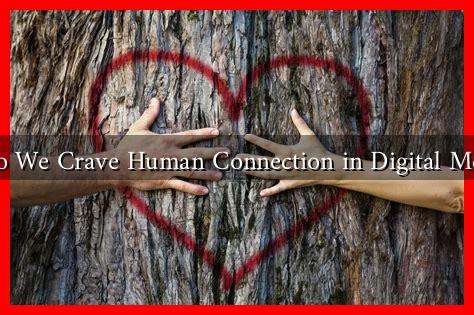-
Table of Contents
Why Do We Crave Human Connection in Digital Messages?
In an age dominated by technology, the way we communicate has transformed dramatically. Digital messages—whether through text, social media, or emails—have become the primary means of interaction for many. Yet, despite the convenience and speed of these platforms, there remains a profound craving for genuine human connection. This article explores the psychological and social factors that drive this craving, supported by research and real-world examples.
The Psychology Behind Our Craving for Connection
Human beings are inherently social creatures. Our brains are wired to seek connections with others, a trait that has evolved over thousands of years. This need for connection is deeply rooted in our psychology and can be understood through several key concepts:
- Attachment Theory: Developed by psychologist John Bowlby, this theory posits that early relationships with caregivers shape our ability to form connections later in life. Secure attachments lead to healthier relationships, while insecure attachments can result in a heightened need for validation and connection.
- Social Identity Theory: Proposed by Henri Tajfel, this theory suggests that our self-esteem is closely tied to our group memberships. In digital communication, we often seek affirmation from our social groups, leading to a craving for connection through likes, shares, and comments.
- Neurochemical Responses: Engaging in social interactions triggers the release of oxytocin, often referred to as the “love hormone.” This chemical response reinforces our desire for connection, making us feel good when we interact with others.
The Role of Digital Communication in Fulfilling Our Needs
Digital communication offers a unique platform for connection, allowing individuals to reach out to others regardless of geographical barriers. However, it also presents challenges that can amplify our craving for genuine interaction:
- Accessibility: With smartphones and the internet, we can connect with anyone at any time. This constant availability can lead to an overwhelming desire for interaction, as we often feel compelled to check our devices for messages.
- Curated Interactions: Social media platforms allow users to present idealized versions of themselves, which can create a sense of disconnection. The disparity between online personas and real-life identities can lead to feelings of loneliness and a deeper craving for authentic connections.
- Instant Gratification: Digital messages provide immediate feedback, which can be addictive. The anticipation of a reply or a like can create a cycle of craving that is difficult to break.
Case Studies and Statistics
Research supports the notion that digital communication can both fulfill and hinder our need for connection. A study published in the journal Computers in Human Behavior found that individuals who engage in more online interactions report higher levels of loneliness. Conversely, those who maintain face-to-face relationships tend to experience greater life satisfaction.
Furthermore, a survey conducted by the Pew Research Center revealed that:
- 69% of adults believe that social media helps them connect with friends and family.
- 54% of respondents feel that social media has made them feel more connected to their communities.
- However, 40% also reported feeling overwhelmed by the pressure to maintain an online presence.
Finding Balance in Digital Communication
While digital messages can facilitate connection, it is essential to strike a balance between online and offline interactions. Here are some strategies to enhance genuine connections:
- Prioritize Face-to-Face Interactions: Whenever possible, opt for in-person meetings or video calls to foster deeper connections.
- Limit Social Media Use: Set boundaries for social media engagement to reduce feelings of overwhelm and disconnection.
- Be Authentic: Share your true self online to encourage others to do the same, fostering a more genuine connection.
Conclusion
The craving for human connection in digital messages is a complex interplay of psychological needs and social dynamics. While technology has revolutionized the way we communicate, it is crucial to recognize the limitations of digital interactions. By understanding the underlying factors that drive our need for connection, we can navigate the digital landscape more effectively and cultivate meaningful relationships. Ultimately, the goal should be to enhance our connections, both online and offline, ensuring that we do not lose sight of the human element in our increasingly digital world.

